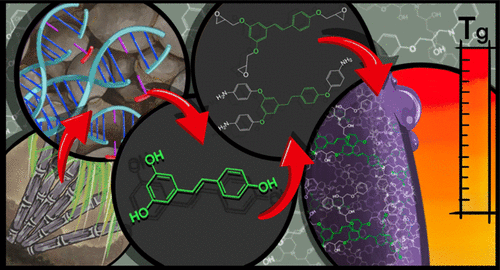当前位置:
X-MOL 学术
›
ACS Sustain. Chem. Eng.
›
论文详情
Our official English website, www.x-mol.net, welcomes your
feedback! (Note: you will need to create a separate account there.)
Synthesis and Characterization of High-Performance, Bio-Based Epoxy–Amine Networks Derived from Resveratrol
ACS Sustainable Chemistry & Engineering ( IF 7.1 ) Pub Date : 2020-08-21 , DOI: 10.1021/acssuschemeng.0c04816 Michael D. Garrison 1 , Markku A. Savolainen 1 , Andrew P. Chafin 1 , Joshua E. Baca 1 , Austin M. Bons 1 , Benjamin G. Harvey 1
ACS Sustainable Chemistry & Engineering ( IF 7.1 ) Pub Date : 2020-08-21 , DOI: 10.1021/acssuschemeng.0c04816 Michael D. Garrison 1 , Markku A. Savolainen 1 , Andrew P. Chafin 1 , Joshua E. Baca 1 , Austin M. Bons 1 , Benjamin G. Harvey 1
Affiliation

|
Resveratrol is a sustainable and versatile bio-derived phenolic compound that has shown promise as a high glass-transition temperature (Tg), flame-resistant building block for thermoset networks. In this study, three components of epoxy thermoset resins were synthesized from resveratrol: trans-resveratrol trisepoxy (1), dihydroresveratrol trisepoxy (2), and a trifunctional amine, 4,4′-((5-(4-(4-aminophenoxy)phenethyl)-1,3-phenylene)bis(oxy))dianiline (4). The epoxy monomers were low melting solids (mp < 80 °C) or thick oils consisting of primarily monomeric trisepoxides. Toxicity testing of 4 revealed that it was not mutagenic and had a low LD50 of 560 mg/kg, an aquatic toxicity of >2000 mg/L, and no cytotoxicity up to its solubility limit. The epoxy monomers were cured with 4,4′-methylenedianiline (3) and 4 to produce four epoxy–amine networks (A–D). Networks C and D, prepared with the resveratrol-derived aniline, contained up to 52.6% bio-based material. The moisture uptake, thermal stability, and dry/wet thermomechanical properties of the networks were measured. The networks had Tg’s as high as 285 °C, approximately 110 °C higher than networks based on petroleum-derived bisphenol A (BPA). In addition, the resveratrol networks had char yields as high as 51 and 46% in nitrogen and air, respectively, compared to ca. 15 and 5%, respectively, for BPA-based networks. Overall, this study shows the advantages of resveratrol-based epoxy and amine monomers as components of sustainable, low-toxicity, high-temperature resin systems.
中文翻译:

源自白藜芦醇的高性能生物基环氧-胺网络的合成与表征
白藜芦醇是一种可持续的,用途广泛的生物来源的酚类化合物,已显示出有望成为高玻璃化转变温度(T g),热固性网络的阻燃构件。在这项研究中,由白藜芦醇合成了环氧热固性树脂的三个组分:反式-白藜芦醇三环氧(1),二氢白藜芦醇三环氧(2)和三官能胺4,4'-((5-(4-(4-氨基苯氧基) )苯乙基)-1,3-亚苯基)双(氧基)二苯胺(4)。环氧单体是低熔点固体(mp <80°C)或主要由单体三环氧化物组成的稠油。4的毒性测试表明,它没有诱变并且LD 50低毒性为560 mg / kg,水生毒性> 2000 mg / L,至溶解度极限无细胞毒性。环氧单体分别用4,4'-亚甲基二苯胺(3)和4固化,生成四个环氧-胺网络(A – D)。用白藜芦醇衍生的苯胺制备的网络C和D包含多达52.6%的生物基材料。测量了网络的水分吸收,热稳定性和干/湿热机械性能。网络有T g高达285°C,比基于石油的双酚A(BPA)的网络高约110°C。此外,与大约相比,白藜芦醇网络在氮气和空气中的焦炭收率分别高达51%和46%。基于BPA的网络分别为15和5%。总体而言,这项研究表明,以白藜芦醇为基础的环氧和胺类单体具有可持续,低毒,高温树脂体系的优点。
更新日期:2020-09-21
中文翻译:

源自白藜芦醇的高性能生物基环氧-胺网络的合成与表征
白藜芦醇是一种可持续的,用途广泛的生物来源的酚类化合物,已显示出有望成为高玻璃化转变温度(T g),热固性网络的阻燃构件。在这项研究中,由白藜芦醇合成了环氧热固性树脂的三个组分:反式-白藜芦醇三环氧(1),二氢白藜芦醇三环氧(2)和三官能胺4,4'-((5-(4-(4-氨基苯氧基) )苯乙基)-1,3-亚苯基)双(氧基)二苯胺(4)。环氧单体是低熔点固体(mp <80°C)或主要由单体三环氧化物组成的稠油。4的毒性测试表明,它没有诱变并且LD 50低毒性为560 mg / kg,水生毒性> 2000 mg / L,至溶解度极限无细胞毒性。环氧单体分别用4,4'-亚甲基二苯胺(3)和4固化,生成四个环氧-胺网络(A – D)。用白藜芦醇衍生的苯胺制备的网络C和D包含多达52.6%的生物基材料。测量了网络的水分吸收,热稳定性和干/湿热机械性能。网络有T g高达285°C,比基于石油的双酚A(BPA)的网络高约110°C。此外,与大约相比,白藜芦醇网络在氮气和空气中的焦炭收率分别高达51%和46%。基于BPA的网络分别为15和5%。总体而言,这项研究表明,以白藜芦醇为基础的环氧和胺类单体具有可持续,低毒,高温树脂体系的优点。











































 京公网安备 11010802027423号
京公网安备 11010802027423号